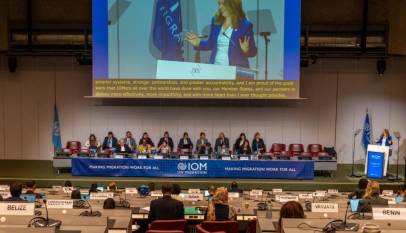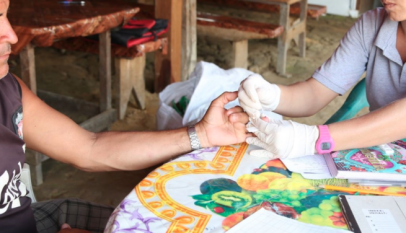Delivering the next generation of vaccines
Immunization is one of the most successful and cost-effective global health policies. It averts 2 million to 3 million deaths annually. An additional 1.5 million deaths could be avoided if global use of current vaccines expanded. But this potential impact only accounts for the diseases that have accessible and effective vaccines.

People at risk of contracting malaria, HIV and AIDS and other diseases of poverty have no recourse to vaccines; or, in the case of tuberculosis, are forced to use a vaccine that is no longer fit for purpose.
If we are serious about ending these diseases by 2030, then we will need new and innovative vaccines. As we mark World Immunization Week, we need to figure out how we can move forward and expand the research and development agenda in order to stimulate the next generation of lifesaving vaccines.
Research funding stagnating since 2008
Research into effective vaccines for HIV and AIDS and malaria is challenging, given the complex biology of the respective diseases. Both diseases, however, have seen candidate vaccines reach the late stage of clinical trial. A 2009 trial on a potential HIV vaccine demonstrated a 30 percent efficacy rate; the malaria vaccine RTS,S showed a 36 percent and 26 percent decrease in clinical malaria cases in children and infants respectively over 3-4 years of follow up.
There are more candidate vaccines in development for both diseases at an earlier stage in the development cycle. Vaccines for both could be transformative. The World Health Organization recognizes that a malaria vaccine could be a game changer in global health. It is estimated, according to the International AIDS Vaccine Initiative, that an AIDS vaccine could avert between 5.2 million and 10.7 million new HIV infections between 2020 and 2030. Even a preventive AIDS vaccine of just 50 percent efficacy given to 30 percent of the population in low- and middle- income countries could avert almost 20 percent of all infections.
However, funding for both diseases has yet to regain its pre-financial crisis peak in 2008-2009. According to the latest GFinder statistics, HIV vaccine research makes up more than half of all R&D spending on the disease: $652 million, or 60 percent, in 2014. Malaria vaccine research received a large bump in 2014, increasing its share of R&D funding from $120 million to $173 million, following several years of declining investment.
There is an existing vaccine for tuberculosis. The bacille Calmette-Guérin vaccine was introduced in 1921, and while it is effective in preventing the disease in children and is considered one of the most successful immunization programs, it does not protect against primary infection and, more importantly, does not prevent reactivation of the disease later in life. What alternatives are on the horizon? There are several vaccine candidates in clinical development at phase II stage, mostly targeting infants and young children, or as potential boosters for the BCG vaccine. Results for these trials to date have been mixed, and some of the potential candidates have shown limited efficacy in infants. As with HIV and malaria, TB vaccine research has suffered consecutive declines in funding since the beginning of the decade.
The patterns are clear. Vaccine research for diseases of poverty is complex, with long lead-in times before a product is available. Work has been ongoing on a HIV vaccine since the 1980s, for example. Investment in the sector has failed to regain the levels it received before the financial crash in 2008-2009, reflecting the fact that global health research is not yet seen as a core issue for global health decision-makers. If we are to harness the latent potential in vaccine research, how are we to do it?
- Sustainable and sufficient funding: Annual funding for global health research for diseases of poverty has stalled, reaching $3.37 billion in 2014. If we are serious about reducing preventable deaths caused by these diseases, this figure needs to be doubled. This will not only provide a stimulus to a sector that has been serially neglected, but will also transform the lives of millions of people living in some of the world’s poorest countries. In Europe, where there is significant scientific and research expertise, civil society has been pushing the European Unionto lead the way in increasing financing for research into diagnostics, treatment, prevention and vaccines.
- A coherent investment strategy: With downward budgetary pressures, it’s important to extract the maximum possible impact from any funding. In Europe, for example, the EU has adopted several policy initiatives to support innovation and research, in conjunction with its development cooperation and global health programs. However, the alignment and synergies between these respective — and often disparate — sectors do not always have the maximum impact possible. In addition, the policy aim of delivering innovation for global health, including for diseases of poverty, is not always apparent. Policymakers need to do better to make sure that talented researchers are able to secure support for the best and most promising projects. We do not want to miss out on revolutionary discoveries because of onerous administrative burdens or restrictions.
- Support for innovation across the development cycle: New models for developing vaccines have shown that they can provide solutions for diseases that have been neglected for lack of market incentive. Product development partnerships are active right now in researching and trialling the next generation of vaccines, working to overcome the obstacles the sector has faced. These partnerships — bringing together academia, public health and the private sector — have reinvigorated the global health research field by translating basic research into real medical interventions, and need support from policymakers and international donors.
We are living in an age of constant medical advances, one in which the power of vaccines has been harnessed to save millions of lives. As we move into the next era of global development policy — the 2030 Agenda for Sustainable Development — we need to secure and build on this progress, to achieve breakthroughs in the fight against diseases such as HIV, TB and malaria. Investing in research and innovation targeted at these diseases now and in the right policy environment could usher in the next revolution in immunization.
(Devex)














